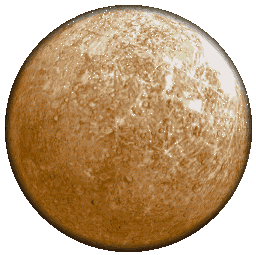Mercury is the closest planet to the sun. Mercury is a battered and baked planet just larger than Earth's moon. Evidence of heavy bombardment from the chais of the formation of the solar system is left in hundreds of craters and resulting lava flows on this small, barren planet. The largest crater is Beethoven at 643 km in diameter and is the largest in the solar system. The largest feature, Carloris Basin, is 1300 km in diameter. Some craters have ice in them even though the planet is so hot because the sun never reaches into the shadows due to the planets tilt and orbit. With no atmosphere, there is a temperature difference of about 600 degrees between the coldest spots and he hottest spots on the planet. Mercury orbits the sun in about 88 Earth days but takes 58 Earth days to rotate once. On this planet a year takes a (Mercury) day and a half.

|
Quick Facts about Mercury | |
|
Topic |
Data |
|
Diameter |
4879.4 km |
|
Density |
5.43 g/cm3 |
|
Mass |
3.303 x 1023 kg |
|
Volume |
6.084 x 1010 km3 |
|
Temperature Range |
-173° C to 427° C |
|
Atmosphere |
Some Hydrogen, Helium, Oxygen |
|
Winds |
None |
|
Moons |
None |
|
Average Distance from Sun |
57,910,000 km |
|
Orbital Period |
0 Years, 87 Days, 23.3 Hours |
|
Rotation |
58 Days, 15.5 Hours |
|
Tilt |
0.00° |
|
Rings |
None |
|
Composition |
Iron Core, Silicate Surface |
|
Magnetic Field |
Slight |









